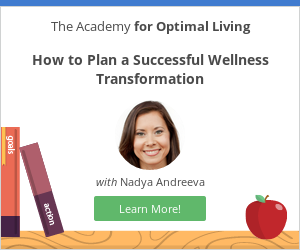How to Plan Successful Wellness Transformation
We all want to feel amazing, have a strong lean body, and an abundance of energy. Unfortunately, just wanting is not enough to achieve it.
As any large project, a successful wellness transformation requires planning, strategy, and commitment. It’s not an easy task to change negative patterns and create a healthy lifestyle, but it’s totally doable if you create a strong foundation. Below The following step-by-step process is based on positive psychology, science of habit change, and my experience of helping hundreds of women change their eating habits, weight, and belief in themselves. Let’s get started!
1. Start with Self-Exploration: To help you determine what you want, think of your past and remember the happiest moments: What did they involve, what were you doing, who was around, how did you look? Recreate it in your mind in as much detail as possible. Get clear on your values, desired outcomes and feelings. What do you value the most in your life? What makes you happy? Outline your values and write all of it down.
2. Imagine and Create Your Wellness Vision: No Vision, No Chance! Albert Einstein said ‘Imagination is every thing. It is a preview of life’s coming attractions.‘ If you don’t know where you want to go, how can you get there? One of the biggest mistakes that most adults make is that they forget how to dream. They complain about the present circumstances but they don’t imagine their ideal world either. As kids, we daydream and imagine. As adults, we frown upon life’s miseries and hope that someone in power will make our life better. To create a strong foundation for your success, you must create your wellness vision.
thing. It is a preview of life’s coming attractions.‘ If you don’t know where you want to go, how can you get there? One of the biggest mistakes that most adults make is that they forget how to dream. They complain about the present circumstances but they don’t imagine their ideal world either. As kids, we daydream and imagine. As adults, we frown upon life’s miseries and hope that someone in power will make our life better. To create a strong foundation for your success, you must create your wellness vision.
Vision serves 2 goals:
- To Inspire You
- To keep you focused on your desired future. It guides you through difficult decisions (e.g.: to have cake or fruit)
Your vision should be based on your passions and values, not on someone else’s! Look within and find what makes YOU happy. In the beginning it can be tempting to write that you will be happy only with a 6 pack abs, particular number in the scale, certain size, or BMI. If this is something that would make you authentically happy, put it down, but be honest with yourself. Is it six pack abs or the feeling of being the center of attention? If you listed a beautiful body in your vision, are you looking for a specific shape, or a feeling of being comfortable in your own skin and being in-love with yourself?
In you wellness vision include answers to the following questions:
- Your Ideal Body: Describe your ideal vision of your physical body. How does it look? How does it feel? How does it move? What do you feel when you see this body in a mirror?
- Your Ideal Relationship with Food: What kind of foods and drinks do you consume in your ideal vision of yourself? How do you feel when you eat? What size portions do you eat? How do you feel in front of your trigger foods?
- Your Ideal Relationship with Exercise: How do you feel when you move your body? Which sports or activities do you love to do? How often do you exercise? Where do you exercise? How do you feel when you exercise?
If you were at your optimum level of health and wellness, what would that look like and feel like? What are the most important elements in your vision?
Write your answers in present tense as if you were telling a story to a friend. Be specific and dream big!
3. Get clear on your WHY. Motivation is crucial to success. You need to be clear on your why before you decide to move forward. Why do you want to create change? Why does this have a major meaning in you life? Why is it important for you to do it now? Make a list of your WHY’s in your journal and review it regularly, especially when feeling low or unmotivated.
4. Crafting and designing. Once you get clear on things that you would like to feel and experience, find images that reflect it and make a collage. Use Pinterest, google image search, magazines, or your own photos. Visual, bright images are a great way to create emotional engagement. Keep a picture of your wellness vision collage on your computer, phone, or print it out and put it on your mirror or fridge. Here’s my vision board http://www.pinterest.com/spinachandyoga/vision/
5. Create a Clear Strategy: Once you know where you would like to move, it’s time to create smart goals. One of the most important steps of a successful wellness transformation is setting goals in a way that is empowering and exciting. These goals should be based on reducing the gap between where you are today and your wellness vision. What actions, habits, and behaviors will help you get to your desired vision? Strategy has to focus on behaviors, not outcomes. To do that, use smart goal setting. SMART is an acronym for Specific, Measurable, Actionable, Realistic and Timely. Studies have shown that people who use SMART goals are more likely to succeed in their quest for better health, ideal weight, and a sense of joy and fulfillment in daily life. By crafting SMART goals, you will obtain clear, concise feedback regarding your progress. Here are some examples of turning a general goal in a SMART goal:
General goal: Be healthy and get into a better shape.
SMART goal: I will eat wholesome fresh meals with vegetables, grains, and healthy proteins 5 days out of 7 for 3 weeks before re-evaluating my goal. I will do yoga and run 3 times a week (each) for 3 weeks and then re-evaluate my fitness goals.
- Specific—Saying that you want to be healthy is great, but not very specific. Instead decide what exactly you would like to do. For example: stop eating junk food or do yoga and run regularly to get into a better shape. The more specific the better!
- Measurable—Let’s say you want to stop eating junk food, so you can make “5 days out of 7 with no junk food as your goal”. If you goal was to do yoga and run on a regular basis to get into a better shape, then a measurable goal would sound like this: “I will do yoga 3 times a week and run 3 times a week with 1 day of rest”.
- Action-Oriented — The goals should be based on behaviors that result in change. Our goal of doing yoga and running 3 times a week each fits well. However, the 2nd goal where we are planning to stay away from junk food 5 days out of 7 is not actionable. It does not specify what you are going to eat! So to make it actionable, it would be better to state it this way: I will eat unprocessed whole meals with grains, vegetables, and healthy proteins 5 days a week.
- Realistic—Many people fail to reach their goals because they set their standards too high. A healthy challenge is motivating, unrealistic goals are de-motivating. Don’t set yourself up for a failure! Setting a goal of 5 days a week of whole meals is more realistic than aiming for 7 from the very start. Same goes for the exercise. You don’t want to aim 2 hours workouts 7 days a week unless you are trying to tire your body out.
- Time-bound —Having a deadline will move you ahead more rapidly, so set some up for each goal. Include both short and long-term goals. Reevaluate your goals on a weekly basis to assess what has worked or what interventions you need to help yourself along. Remember, it takes three to six months for new habits to become permanent and to begin to see noticeable changes.
6. Commit to your vision and new goals: review daily, make it your focus, your lighthouse, your commitment. Whenever you feel that you had a detour, re-commit. Failure is not an option. Re-evaluate, learn from failures, adapt your goals, be flexible but stay committed to your vision.
7. Substituting/changing negative patterns and habits: Building new habits is hard but doable, breaking old habits is pretty much impossible. However, you can substitute bad habits if you can find a new activity that gives you the same reward. To do that you need to get very clear on what reward you get from engaging in your bad habit (overeating, smoking, late night snacking). What craving does it satisfy for you? Also note time of the day when you tend to engage in it, your emotional state, and location. Then try to find another action that would give you the same reward or satisfy the same craving. For example, if you crave a break and go to the kitchen to take a snack, try going for a walk; if you crave pleasure in the evening after a long day of work and reach for chocolate, try listening to beautiful music. It is all about experimentation and finding something that would really satisfy the craving in a similar way that your current bad habit does.
8. Finding support and creating accountability. What people, resources, systems, and environments can you draw on to help you realize your vision and meet your challenges? Who can hold you accountable? Accountability creates the environment for your new habits to succeed. Some examples of accountability: commit to a friend, post weekly updates on Facebook or Twitter, blog about it, join a challenge with your family or co-workers.
9. Focus on what you want, not what you don’t like: “Whatever we focus on grows!” If we focus on the positive, there will be more of it appearing in our life. Unfortunately, it is true with the negative thoughts, as well. That’s the way positive psychology explains this phenomenon. The field of Positive Psychology and modern neuroscientists have been able to prove that our attitude and perception have a strong impact on reality. Our brain will rewire the entire body to make it correspond to the current beliefs. So if you believe that you are overweight, it will be so; if you are certain that you are getting old quickly, you might. On the other hand, if you think that your body is strong and beautiful, your body will respond to that belief as well. Wherever you put the mind, the body will follow.
Most of the time we talk about and focus on the things that we don’t like about our bodies: flabby stomach, wrinkles, not the right size on jeans, thin hair… the list goes on and on… Negative thoughts are limiting. We are programming ourselves with ‘I can’t’, and ‘I don’t’ messages into a negative body image and low self-esteem. For the next 7 days write down at least 5 positive affirmations about yourself and at least 3 specifically about your body. More is better but 5 is a good beginning. Do it on your phone, on facebook, in a notepad, wherever you want! Start by writing down specific moments when you’ve done something good for yourself and felt good about your body. Big or small – everything counts!
10. Celebrate your success early on – It is a must to stay motivated and increase your self-confidence. Try to celebrate with non-food related experiences. Some small successes worth celebrating: making a healthy breakfast, moving your body, taking a walk, going to sleep on time, choosing a healthy dessert. Ideas to celebrate: buy new lingerie just for yourself, sip delicious tea watching sunset, have a long dinner with your friend, walk under the moon or under the sun, get your favorite body therapy.
Did you like these tips? Want more guidance? Check out my full one hour class on Creating a Successful Wellness Transformation at the en*theos Academy for Optimal Living.
This is my absolute best stuff shared in a really fun, high energy, 30-minute video format (you can also download MP3s and a PDF for the class). Check it out here!
P.S. I’m not the only one serving up wisdom at the Academy. From health, nutrition and fitness to creativity, productivity, spirituality, relationships and parenting, hundreds of extraordinary teachers are sharing their expert advice on everything that goes into optimizing our lives – all in one place!
There are already 300+ courses to choose from (with 100+ new classes added every month), each with 10 Big Ideas that can change your life. Check out the Academy’s class catalog here – it’s huge!











